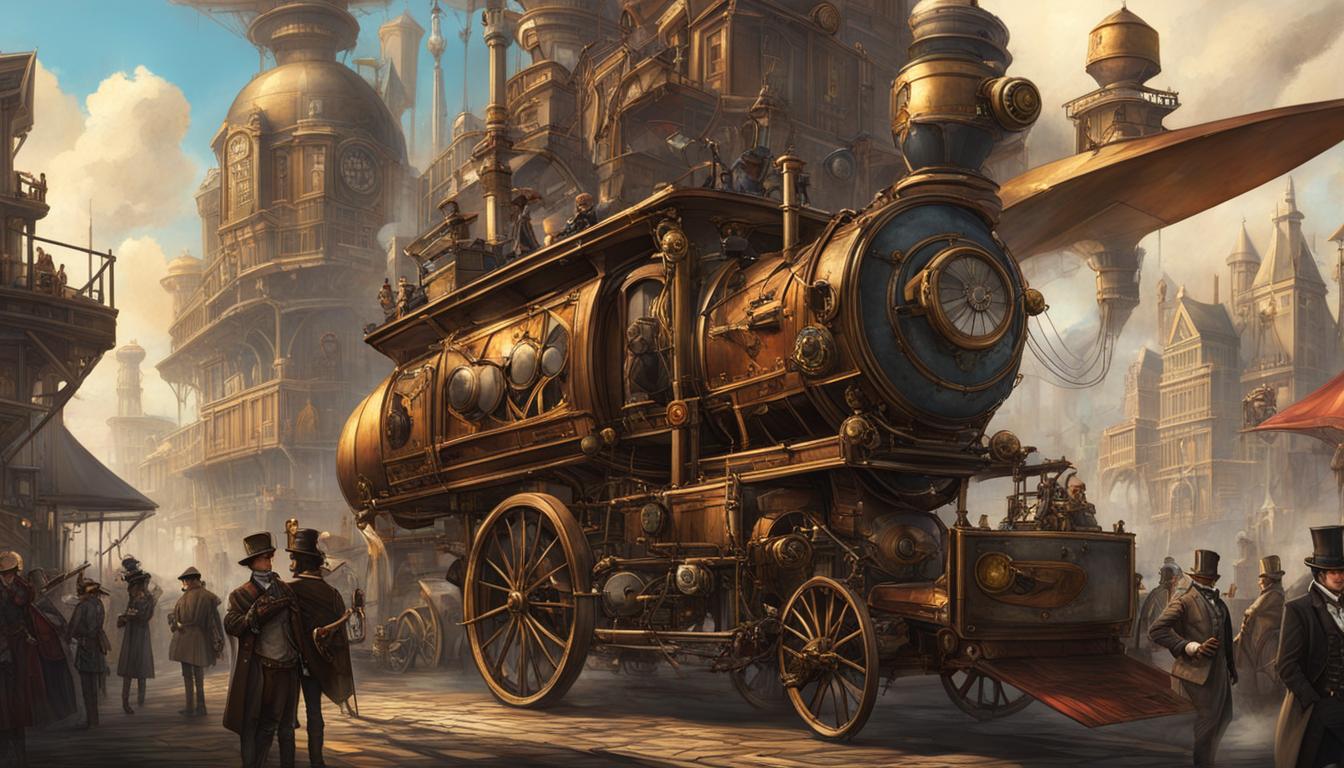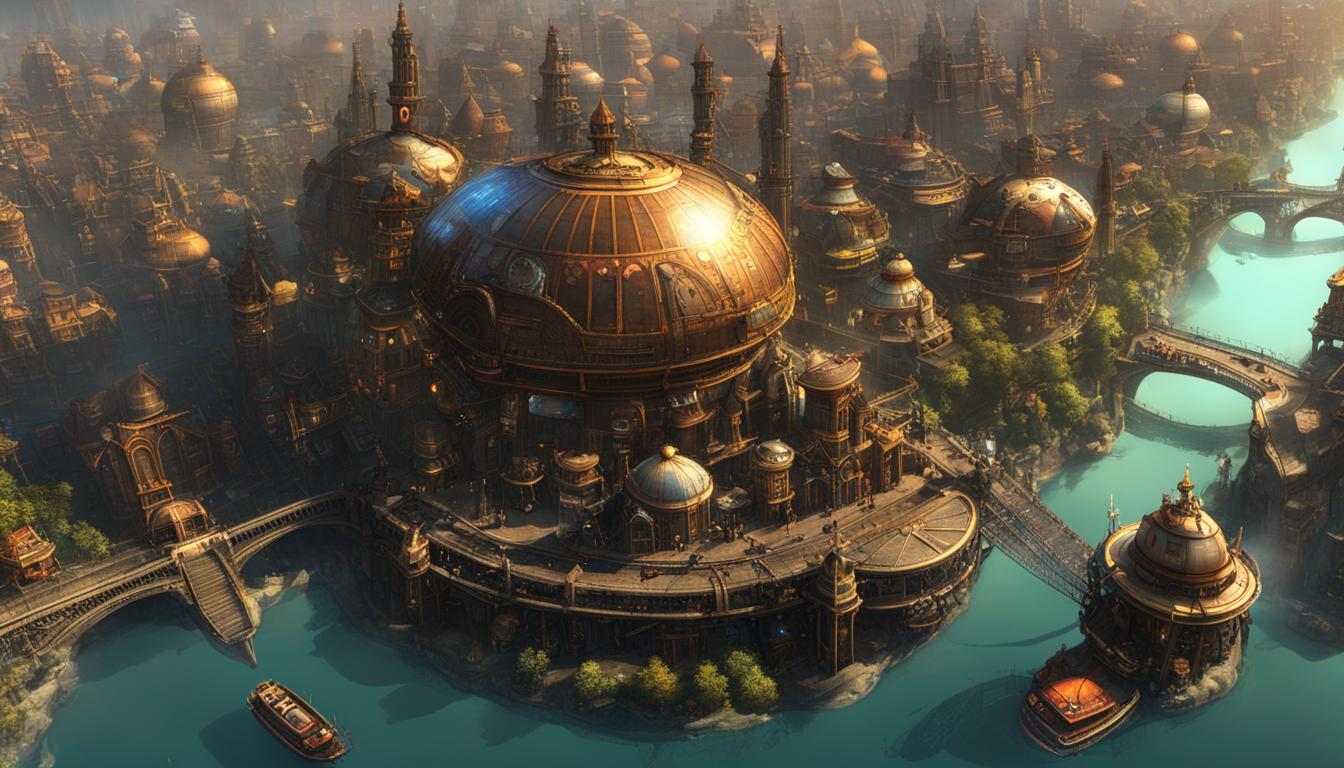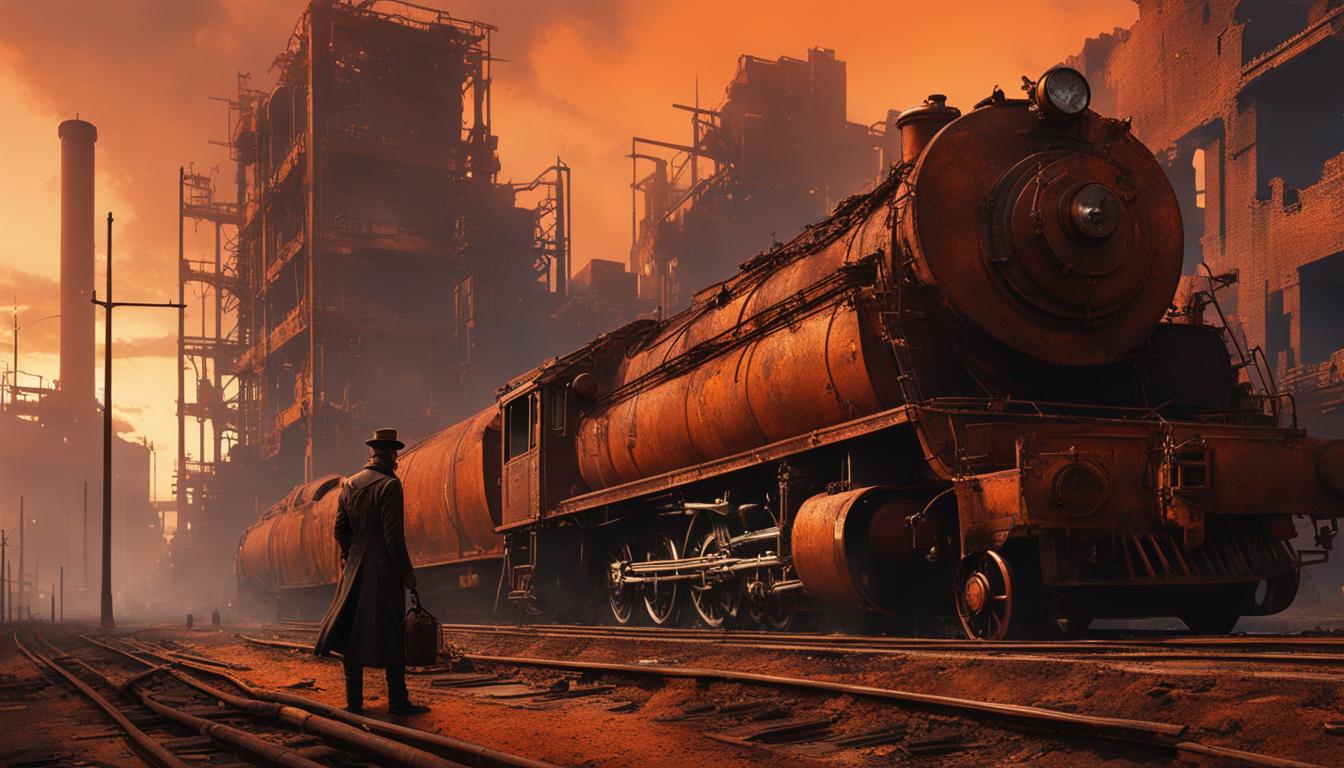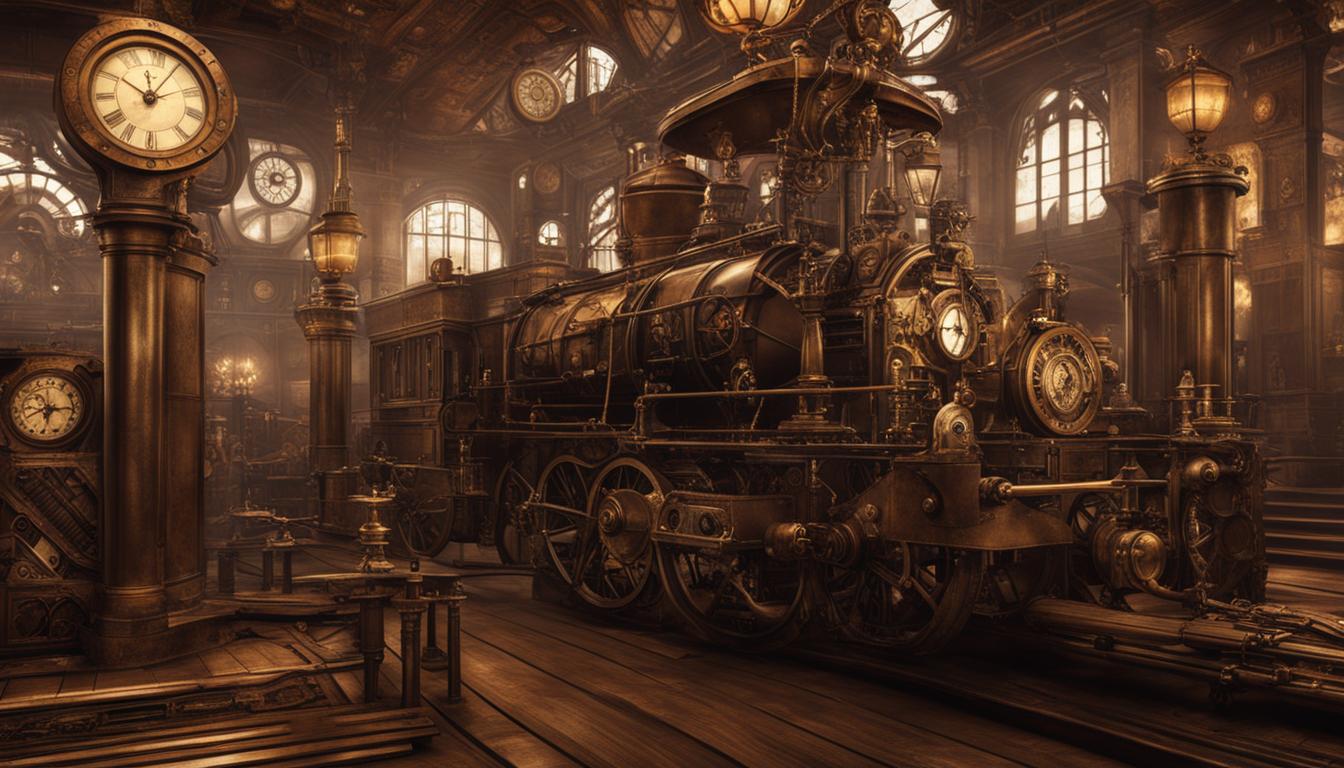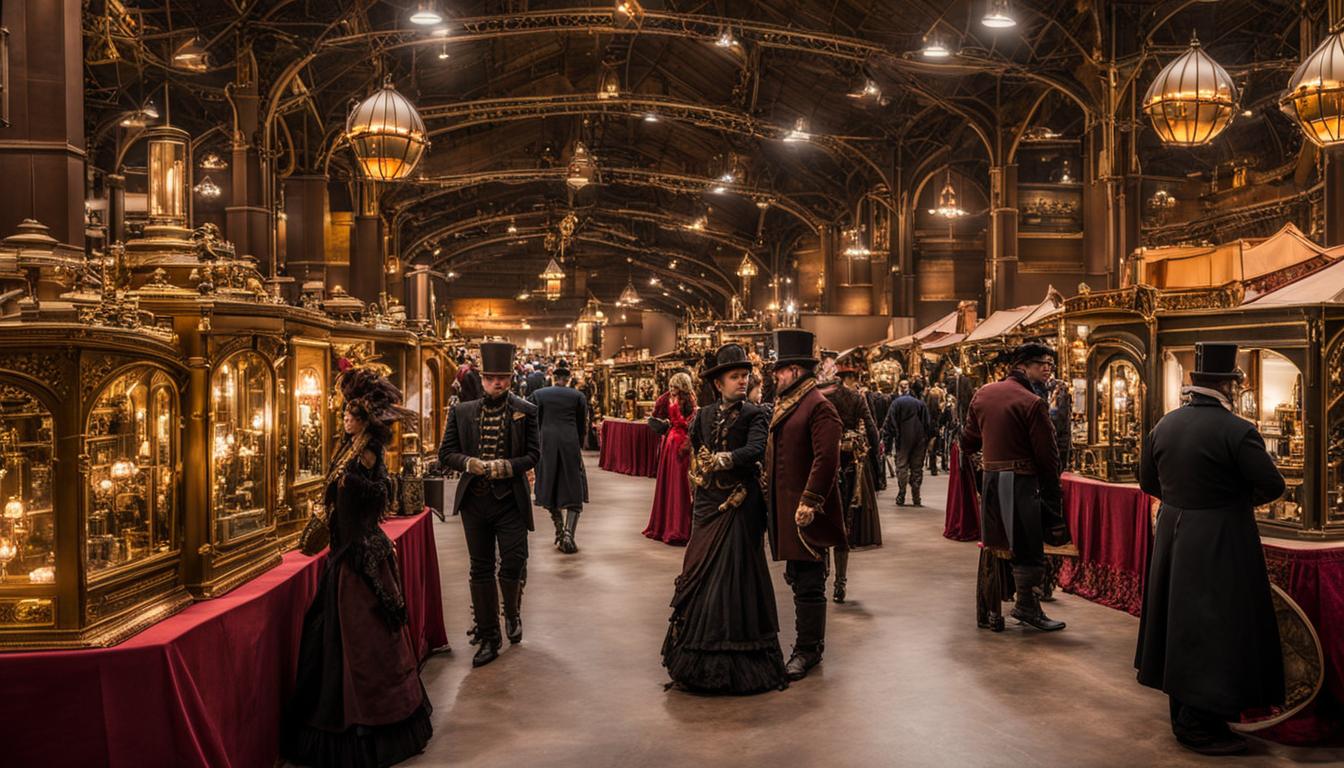Step into a world where Victorian elegance collides with steam-powered technology. The resurgence of steampunk themes in modern television has captivated audiences with its blend of history, imagination, and retro-futuristic aesthetics. From classic literature adaptations to original series, steampunk’s comeback in TV shows has brought a touch of mystery and wonder to our screens.
Steampunk, a subculture that emerged from the pages of literature, has evolved into a multi-faceted movement encompassing art, fashion, and music. Inspired by the Victorian Era and the Industrial Revolution, the genre has gained popularity worldwide. Its influence extends beyond entertainment, shaping modern technology and even predicting future advancements.
Key Takeaways:
- Modern TV shows have embraced steampunk themes, infusing their narratives with Victorian aesthetics and steam-powered technology.
- Steampunk’s resurgence in TV series highlights the genre’s enduring appeal and its ability to transport audiences to alternate histories and imaginative worlds.
- Steampunk has expanded from literature to become a globally recognized movement, influencing various forms of media and art.
- The blend of Victorian elegance and retro-futuristic elements in steampunk fashion and design has gained popularity in recent years.
- Steampunk’s influence extends beyond entertainment, shaping modern technology and inspiring advancements in various fields.
Historical Context of Steampunk
The Steampunk movement draws inspiration from the Victorian Era and the Industrial Revolution, both of which had a profound impact on its themes and aesthetics. The Victorian Era, spanning from 1837 to 1901, was known for its strict social hierarchy and rapid social and economic changes. It served as the backdrop for the Steampunk Movement, providing a rich historical context for its narratives.
The Industrial Revolution, which took place from the late 18th to the early 19th century, brought about a wave of technological advancements powered by steam. This era of steam-powered factories, locomotives, and machinery laid the foundation for the iconic imagery and retrofuturistic elements commonly associated with Steampunk.
| Victorian Era | Industrial Revolution | |
|---|---|---|
| Social Context | Strict social hierarchy, rapid social and economic changes | Transition from agrarian to industrial society, rise of factories and urbanization |
| Technological Advancements | N/A | Steam-powered machinery, locomotives, factories |
| Cultural Impact | Influenced art, literature, and fashion of the time | Served as inspiration for Steampunk themes and aesthetics |
“Steampunk emerged as a subgenre of science fiction and fantasy literature in the 1980s, incorporating Victorian-era aesthetics and steam-powered technology. It pays homage to the rich history of the Victorian Era and the transformative impact of the Industrial Revolution.”
Steampunk’s origins in literature can be traced back to authors like Jules Verne and H.G. Wells from the late 19th and early 20th centuries. These literary pioneers laid the foundation for the genre’s exploration of alternate histories and fantastical technological advancements. Today, Steampunk continues to evolve and expand its influence across various forms of media, from film and television to art and fashion.
Key Figures in Steampunk
Steampunk owes much of its cultural significance to the contributions of key figures in literature, film, and music. These pioneers and influencers have shaped the genre and helped it gain popularity among enthusiasts worldwide.
Literary Pioneers
Steampunk literature can trace its roots back to the late 19th and early 20th centuries, with authors like Jules Verne and H.G. Wells. These literary giants introduced readers to fantastical worlds and imaginative technology, setting the foundation for the steampunk movement.
In more recent times, authors such as William Gibson, K.W. Jeter, and Bruce Sterling have revitalized the genre with their modern steampunk creations. Their works combine elements of science fiction, fantasy, and Victorian-era aesthetics, captivating readers with alternate histories and exciting adventures.
Film Influencers
Films have played a significant role in bringing steampunk themes to the big screen, expanding the genre’s reach and inspiring new audiences.
Notable films like “The League of Extraordinary Gentlemen” and “The City of Lost Children” have embraced the steampunk aesthetic, immersing viewers in visually stunning worlds filled with steam-powered contraptions and intricate Victorian designs. These cinematic masterpieces have become touchstones for the genre, influencing subsequent steampunk visual media.
Music Contributors
Steampunk music bands have added a unique auditory dimension to the genre, contributing to its rising popularity.
Music groups like Abney Park and The Cog is Dead have created a distinct steampunk sound, blending elements of rock, folk, and electronic music. Their imaginative lyrics and Victorian-inspired stage presence transport listeners to a world where steam-powered airships sail through the skies and clockwork automatons roam the streets.
| Key Figures | Contribution |
|---|---|
| Jules Verne | Pioneered steampunk themes in classic literature |
| H.G. Wells | Introduced fantastical technology and alternate histories in steampunk literature |
| William Gibson | Revitalized steampunk with modern interpretations in literature |
| K.W. Jeter | Explored steampunk aesthetics and alternate histories in literature |
| Bruce Sterling | Expanded the boundaries of steampunk literature with imaginative storytelling |
| “The League of Extraordinary Gentlemen” | Brought the steampunk aesthetic to the big screen |
| “The City of Lost Children” | Inspired audiences with its visually stunning steampunk world |
| Abney Park | Created a unique steampunk sound in music |
| The Cog is Dead | Contributed to the rising popularity of steampunk music |
Steampunk in Literature
Steampunk literature encompasses a wide range of works that combine elements of science fiction, fantasy, and Victorian-era aesthetics. It has a rich history, with classic works and contemporary masterpieces captivating readers around the world.
Classic steampunk literature includes iconic novels like H.G. Wells’ “The Time Machine” and Jules Verne’s “Twenty Thousand Leagues Under the Sea.” These influential works transport readers to imaginative worlds filled with steam-powered technology, elaborate machinery, and alternate histories.
Tim Powers’ “The Anubis Gates” and Scott Westerfeld’s “Leviathan” series are examples of contemporary steampunk masterpieces. These novels seamlessly blend historical settings with extraordinary inventions, creating immersive and thrilling reading experiences.
| Classic Works | Contemporary Masterpieces |
|---|---|
| “The Time Machine” by H.G. Wells | “The Anubis Gates” by Tim Powers |
| “Twenty Thousand Leagues Under the Sea” by Jules Verne | “Leviathan” series by Scott Westerfeld |
The appeal of steampunk literature lies in its ability to transport readers to an era of adventure, mystery, and technological innovation. It offers a unique blend of historical inspiration and futuristic imagination, making it a genre cherished by fans worldwide.
Steampunk Quotes:
“The past is an illusion, but a very persistent one.” – Albert Einstein
“Steampunk is like an alternate, steam-powered version of the past that never was, but should have been.” – Unknown
“Steampunk literature is a captivating journey through time, where the impossible becomes possible and the ordinary becomes extraordinary.” – Anonymous
Key Features of Steampunk Literature:
- Blending of Victorian-era aesthetics and steam-powered technology
- Exploration of alternate histories and social commentary
- Intricate world-building and attention to detail
- Diverse range of characters and settings
Steampunk in Visual Media
Steampunk themes have made a captivating presence in both film and television, transporting viewers to a world that merges Victorian elegance with steam-powered technology. Films like “Wild Wild West” and the BBC’s “Sherlock Holmes” series have embraced the steampunk aesthetic, creating visually stunning and immersive experiences for audiences. Additionally, the art and design world has been influenced by steampunk, with installations and architectural designs showcasing the genre’s distinctive aesthetics.
In film and television, steampunk themes offer a unique blend of historical charm and futuristic possibilities. “Wild Wild West,” directed by Barry Sonnenfeld, is a prime example of steampunk in film, featuring an alternate history where cowboys and steam-powered gadgets coexist. The BBC’s “Sherlock Holmes” series, with its meticulously crafted sets and costuming, captures the essence of steampunk while staying true to the detective’s Victorian origins.
The influence of steampunk can also be seen in the art and design world. Artists and architects draw inspiration from the genre’s combination of industrial aesthetics, intricate mechanical workings, and Victorian elegance. Steampunk art installations, such as interactive sculptures and kinetic art pieces, provide a glimpse into a world where pipes, gears, and clockwork take center stage. Architectural designs inspired by steampunk often feature elements like exposed gears, brass accents, and ornate details, creating a fusion of old-world charm and futuristic innovation.
Steampunk seamlessly blends the elegance of the Victorian era with the imaginative possibilities of steam-powered technology, captivating audiences in film and television and inspiring awe in the art and design world.
Steampunk’s influence on visual media has extended beyond the big screen and art galleries. The genre has also found a place in video games, with titles like “Bioshock Infinite” incorporating steampunk elements in their design and storytelling. These games transport players to fantastical worlds filled with airships, mechanical contraptions, and anachronistic technology, immersing them in the rich and visually striking steampunk universe.
Overall, steampunk’s presence in visual media has sparked the imagination of viewers and inspired artists and designers to create works that pay homage to the genre’s unique blend of history, technology, and creativity.
| Film | Television | Art and Design | Video Games |
|---|---|---|---|
| “Wild Wild West” “The City of Lost Children” “The League of Extraordinary Gentlemen” |
BBC’s “Sherlock Holmes” series Steampunk-inspired episodes in shows like “Doctor Who” |
Steampunk art installations Architectural designs with steampunk elements |
“Bioshock Infinite” “Dishonored” “Arcanum: Of Steamworks and Magick Obscura” |
Steampunk Aesthetic and Fashion
Steampunk fashion has grown in popularity, combining Victorian-era clothing and accessories with mechanical and retrofuturistic elements. This unique style incorporates corsets, waistcoats, top hats, and lace-up boots, all reminiscent of the Victorian era. However, what sets steampunk fashion apart is the addition of gears, cogs, and other mechanical embellishments.
High fashion brands like Prada and Dior have embraced the steampunk aesthetic, featuring steampunk-inspired designs on runways and in their collections. These fashion houses have elevated steampunk to a new level, blending the elegance of Victorian fashion with modern interpretations.
“Steampunk fashion is all about embracing the past while creating an imaginative and stylish aesthetic. It allows individuals to express their creativity and showcase a love for history, technology, and individuality.” – Fashion Designer
In addition to clothing, steampunk accessories and decor play an essential role in capturing the essence of the aesthetic. Jewelry, such as pocket watches, goggles, and compasses, are commonly worn as statement pieces. Home decor items, like brass or copper accents, vintage-looking furniture, and retro-inspired gadgets, further contribute to the steampunk atmosphere.
Steampunk Clothing and Accessories
When it comes to steampunk clothing and accessories, the possibilities are endless. Here are some key elements commonly found in steampunk fashion:
- Corsets and waistcoats: These pieces provide the foundation for a steampunk outfit, enhancing the silhouette and emphasizing Victorian-era style.
- Top hats and goggles: These iconic accessories add a touch of mystery and adventure to the overall look.
- Lace-up boots and gloves: These details contribute to the Victorian aesthetic and complete the steampunk ensemble.
- Aviator jackets and military-inspired coats: These outerwear pieces add a rugged and adventurous vibe to the outfit.
When it comes to accessories, steampunk enthusiasts often incorporate gears, keys, and other mechanical elements into their jewelry. These unique pieces serve as conversation starters, reflecting the wearer’s love for the steampunk genre.
Steampunk Gadgets and Decor
Steampunk decor and gadgets bring the aesthetic to life beyond fashion. Here are some examples of popular steampunk-inspired items:
- Brass and copper accents: These metals are commonly used in steampunk-inspired home decor, adding a touch of vintage elegance.
- Retrofuturistic gadgets: Clocks, compasses, and telescopes with a steampunk twist are sought-after items for steampunk enthusiasts.
- Industrial lighting fixtures: Unique lamps and light fixtures with exposed bulbs and metal elements create an atmospheric steampunk ambiance.
- Art installations: Steampunk-inspired sculptures and art installations, often incorporating gears and mechanical elements, showcase the creativity and imagination of steampunk artists.
Whether it’s through clothing or home decor, steampunk offers a way for individuals to express their love for the Victorian era and retrofuturistic technology. The steampunk aesthetic allows for a blend of history, fantasy, and individuality, making it a captivating and enduring style.
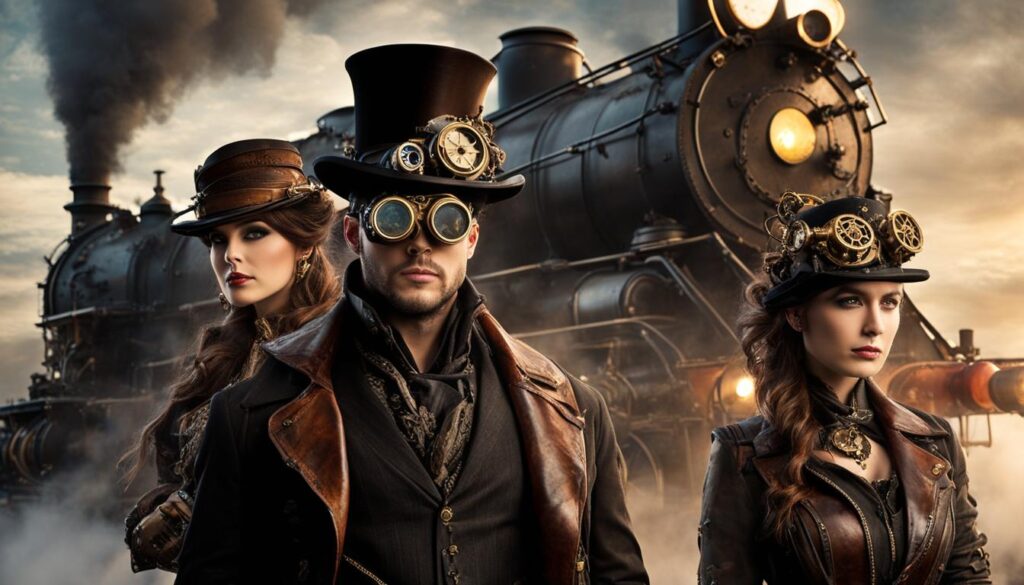
Steampunk in Pop Culture
The influence of steampunk themes has permeated popular culture, making its mark in various forms of media. From television shows to movies and video games, steampunk aesthetics and concepts continue to captivate audiences worldwide.
Doctor Who
One notable example of steampunk’s presence in pop culture is the long-running British television series, Doctor Who. The show has incorporated steampunk elements in several episodes, transporting viewers to a world where Victorian-era fashion and steam-powered technology coexist with futuristic concepts. The TARDIS, the Doctor’s iconic time-traveling spaceship, is often depicted with a blend of Victorian and futuristic design, embodying the essence of steampunk.
Wild Wild West
Steampunk themes also found their way onto the big screen with the 1999 film adaptation of Wild Wild West. Set in the American Old West, the movie features an intriguing mix of Western and steampunk elements. From steam-powered contraptions and intricate gadgets to elaborate costumes, Wild Wild West combined classic Western storytelling with the visual allure of steampunk.
Bioshock Infinite
Video games have also embraced the steampunk genre, none more prominently than Bioshock Infinite. This highly acclaimed game takes players on a journey through the floating city of Columbia, set in an alternate history where steam-powered machinery and Victorian aesthetics dominate. The game’s stunning visuals and immersive storytelling showcase the enduring appeal of steampunk in the gaming world.
| Television Show | Movie | Video Game |
|---|---|---|
| Doctor Who | Wild Wild West | Bioshock Infinite |
| Steampunk elements incorporated in various episodes | Combines Western and steampunk elements | Set in an alternate history with steam-powered machinery |
| Blends Victorian fashion with futuristic concepts | Showcases elaborate costumes and intricate gadgets | Embraces the visual allure of steampunk |
These examples illustrate the widespread presence of steampunk in popular culture, demonstrating its ability to transport audiences to imaginative worlds that blend the past and future with an unmistakable aesthetic appeal.
Conclusion
As the influence of the Steampunk Movement continues to grow, it is evident that this unique blend of Victorian-era aesthetics and steam-powered technology has captivated audiences worldwide. Steampunk has made a resurgence in modern television, with TV shows embracing its themes and creating immersive experiences for viewers. The movement draws inspiration from the Victorian Era and the Industrial Revolution, incorporating elements of science fiction, fantasy, and social commentary.
Steampunk’s impact extends beyond literature and television, influencing art, fashion, music, and even technology. High fashion brands like Prada and Dior have embraced the steampunk aesthetic, while steampunk accessories and decor feature brass, copper, and intricate mechanical workings. In the world of music, bands like Abney Park and The Cog is Dead have contributed to the movement’s popularity.
Looking to the future, steampunk shows no signs of slowing down. With emerging trends and a global impact, the genre continues to evolve and captivate audiences. Steampunk’s influence can be seen in popular culture, from TV shows like Doctor Who to video games like Bioshock Infinite. It is a movement that embraces the past while offering an alternate vision for the future. With its captivating visuals and thought-provoking narratives, steampunk will undoubtedly shape the entertainment landscape for years to come.
FAQ
What is the Steampunk Movement?
The Steampunk Movement is a subculture that combines Victorian-era style with steam-powered technology.
What forms of art does Steampunk encompass?
Steampunk has expanded from literature to include art, fashion, and music.
What does Steampunk draw inspiration from?
The movement draws inspiration from the Victorian Era and the Industrial Revolution.
Where can Steampunk themes be seen?
Steampunk themes can be seen in both classic and contemporary literature and visual media.
Has Steampunk influenced technology?
Yes, the movement has influenced modern technology and predicted future advancements.
What do Steampunk themes often explore?
Steampunk themes often explore alternate histories and social commentary.
Is Steampunk popular globally?
Yes, Steampunk’s influence can be seen globally, with emerging trends in the genre.
What historical periods influenced Steampunk?
The Victorian Era and the Industrial Revolution had significant influences on the Steampunk Movement.
When did the Steampunk Movement start?
The Steampunk Movement started as a subgenre of science fiction and fantasy literature in the 1980s.
Who were the pioneers of Steampunk literature?
Pioneers of Steampunk literature include Jules Verne, H.G. Wells, William Gibson, K.W. Jeter, and Bruce Sterling.
What are some examples of Steampunk literature?
Examples of Steampunk literature include “The Time Machine” by H.G. Wells and “Twenty Thousand Leagues Under the Sea” by Jules Verne.
How has Steampunk influenced visual media?
Steampunk themes can be seen in films like “The League of Extraordinary Gentlemen” and “The City of Lost Children” and television shows like the BBC’s “Sherlock Holmes” series.
What is Steampunk fashion?
Steampunk fashion incorporates Victorian-era clothing and accessories with mechanical and retrofuturistic elements.
What are some examples of Steampunk in pop culture?
Steampunk can be seen in TV shows like Doctor Who and movies like “Wild Wild West” and video games like Bioshock Infinite.
What is the conclusion about Steampunk?
Steampunk has had a significant influence on various forms of media and art and continues to evolve and grow in popularity.

